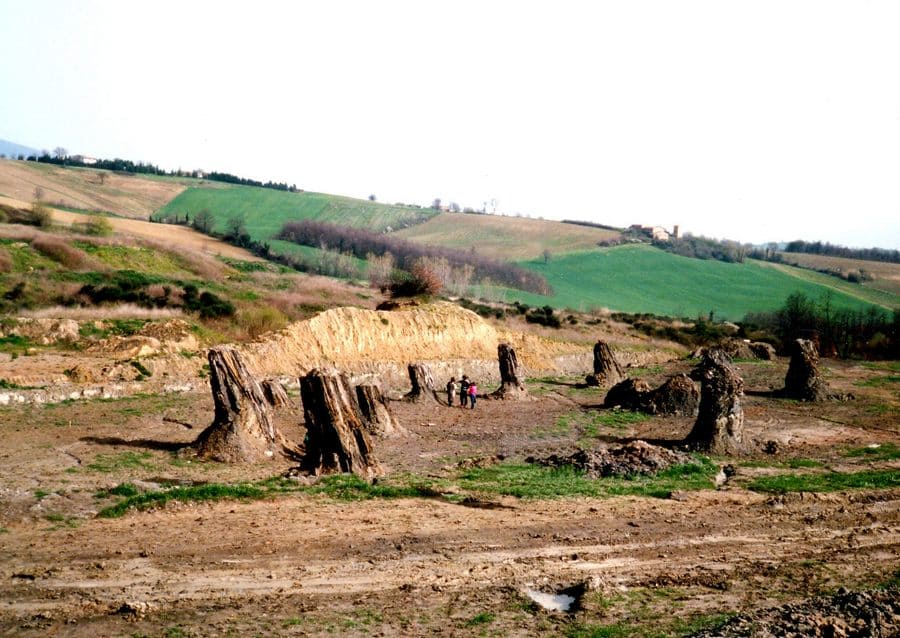The Fossil Forest of Dunarobba, a journey to the beginning of Time
A break in San Gemini can be a unique and unforgettable experience because you can take a dip in the past and retrace different historical periods.
In very few places in the world, it is possible to visit a fossil forest dating back to 3 million years ago in the morning, spending the afternoon among the ruins of a Roman city as Carsulae or Otricoli and then enjoying an aperitif or dinner in the heart of the medieval village of San Gemini. During a holiday in Umbria, everything is possible and very easy to organize.
So, to start your personal journey through the millennia discover all the advice to visit the Fossil Forest of Dunarobba, a unique natural monument for its perfect state of conservation.
A fortuitous discovery
The Dunarobba site was discovered by accident in the late 1970s during excavations to extract clay.
After the first moment of disbelief arising from the sight of a series of perfectly preserved millennial trunks, excavation activities were organized to understand the dimensions of that phenomenon.

The Dunarobba forest, 3 million years of history
The Dunarobba forest covers an area of about 8 hectares and consists of 50 huge vertical trunks height approximately 5-8 meters.
The wood of these trunks has maintained its original characteristics as well as the soil in which they sink their roots. According to studies, these trees date back to the Pliocene Era between 3 and 2 million years ago.
Probably these 50 trunks belong to a type of extinct plant but with characteristics very close to those of the Sequoia sempervirens, a plant that can reach100 meters in height and today is present only in a restricted area of California.
Some trunks of the Dunarobba fossil forest are protected by wooden huts to preserve their perfect state of conservation. Probabily other trunks will be visible in the coming years, 21 trees have been already identified and wait to be unveiled to the eyes of the world.
Why the Dunarobba forest is so well preserved?
The Dunarobba forest is characterized by a perfect state of conservation because its plants have been progressively covered with clay-rich sediments and at the same time they have slowly sunk into the ground.
The studies of this fossil forest indicate that during the Pliocene Era, the climate in Umbria was hot and humid and its gradual cooling favoured the extinction of this type of conifer.
The extiction of the Forest was, also caused by the particularly marshy soils because of its proximity to the Lake Tiberino that covered the whole region.

The Botanic Paleontological Center
This centre was built only at the end of the 1990s to offer to the visitors of the Dunarobba Fossil Forest the chance to discover its original aspect and to understand which mammals lived there.
Near this naturalistic site, in fact, it has been found several important fossils of very large animals, probably Mammut, that are now displayed in the centre.
Useful information to plan a visit to the Fossil Forest of Dunarobba
Discover information and tips to plan your visit to the Dunarobba Forest.
How to reach the Fossil Forest
The Fossil Forest of Dunarobba is located in Vocabolo Pennicchia in Avigliano Umbro in the province of Terni just 13 km from the village of San Gemini.
To reach this attraction you can take the SP 41 or the SP 113 and once you reach Avigliano Umbro you must follow the signs for Vocabolo Pennicchia.
Opening hours
Dunarobba Fossil Forest can be visited only with the support of a guide, the duration of the tour is around 50 minutes. The days and opening times of this geological site vary according to the periods of the year. In April, May, June, September and October, guided tours take place on Tuesday and Wednesday at 10.30am and 11.45am, Thursday, Friday, Saturday and Sunday also at 3.30pm and 4.45pm.
In July and August guided tours take place from Tuesday to Sunday at 10.30am, 11.45am, 4.30pm and 5.45pm, while from November to March they take place from Tuesday to Friday at 10.30am and 11.45am and on Saturday and Sunday at 10.30am, 11.45am, 2.15pm and 3.30pm.
Ticket rates
The cost of the full ticket is 5 euros and children under 5 years enter for free.
Useful information
The Dunarobba forest is a unique geological site in the world and during a visit, it is not allowed to touch the mummified trunks and it is essential to collect paper or other material that can inadvertently fall to the ground.
More advice
After a visit to the Fossil Forest, it’s recommended a stop at the Grotta Bella, just 12 km from Avigliano Umbro. Probably this ravine on the slopes of Monte L’Aiola was used for housing purposes from the end of the 6th century. B.C. to the V-VI century A.D.
